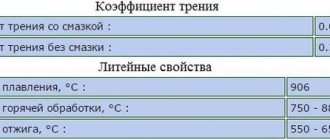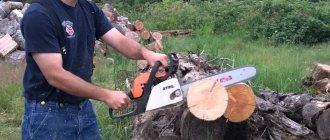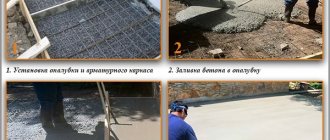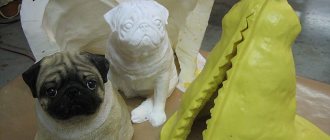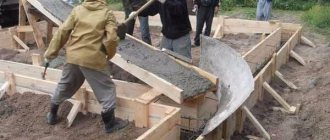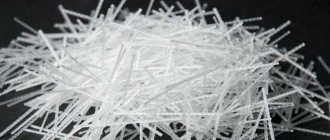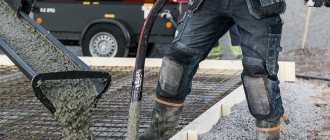The best option for making concrete products is a concrete mold. Its creation at home requires accurate calculations, knowledge of the characteristics of the material used and the future sample, and control of the production process. The matrices are strong and stable, easy to use, designed for repeated use, and no additional construction equipment is needed during production.
For small-scale construction work, according to industry experts, self-production of concrete molds is very profitable, since savings reach 70%.
When are they needed?
Molds for concrete products are indispensable in the manufacture of construction and decorative products by casting. The smaller and more refined the parts, the higher the quality requirements for the matrices. With their help, various construction samples and products for concrete decorations are produced:
Adaptations are necessary for those who make paving slabs.
- blocks for construction;
- fencing;
- paving slabs;
- reinforced concrete slabs;
- architectural accessories;
- blocks or rings for fireplaces;
- drainage trays;
- monolithic or hollow products.
Reviews
This year my husband and I got married and decided to buy a home. There wasn't enough money to buy a new one. We settled on building a house, but the option is also not a cheap one. To reduce costs, we used polystyrene foam formwork. We managed to spend less money and were able to build a house faster.
Olya. Krasnodar.
Our company is engaged in the construction of houses. Pouring a concrete base using foam blocks significantly reduces the time for building construction.
Alexander. Chrysostom
What are they made from?
The variety of concrete products requires suitable raw materials in order to produce appropriate molds for concrete products depending on the specifics of their use. Materials are selected according to technical parameters, processing methods, quality characteristics, and price category of the finished product.
Elastomers
Silicone stencils are convenient to use when you need to make something voluminous.
Elastomeric forms are used in the manufacture of complex volumetric structures that require precise geometric calculations, samples with small details, and high-precision bas-reliefs. It is difficult to make such a form at home, since it requires specialized cooking and crushing equipment. In addition, due to the intricacies of working with substances, consultation with a specialist is required before starting work. Inexpensive silicone stamps from China are popular for casting concrete under artificial stone. The following components are used in the manufacture of elastomeric matrices:
- synthetic rubber;
- formoplast;
- compounds made of polyurethane or silicone.
Plastic
If the slab does not need to be calculated too accurately, then this type of stencil is suitable for it.
The production of large blocks and slabs that do not require precise calculations is carried out using plastic matrices. The main method for producing plastic molds is vacuum molding. The materials from which they are made are shown in the table:
| Types of plastic | Peculiarities |
| Fiberglass | Possible cracks in the product due to poor adhesion to the cement matrix |
| Hard | Used for casting paving slabs, curbs, paving stones |
| Tendency to warp | |
| ABS sheet | Suitable for making small products |
| Tendency to delamination | |
| The need to use silicone lubricant | |
| Film or sheet polystyrene | Fragile |
| Good reproduction of the texture of the samples | |
| PVC plastic | High strength |
| Does not require lubrication or cleaning due to weak adhesion |
It is not often that you see fiberglass matrices used in the manufacture of products.
Fiberglass molds and ABS plastic dies are used less frequently when molding concrete products. Professional builders recommend that when making concrete blocks using plastic, make sure that there is rigid formwork. Thanks to it, the sample will acquire the desired relief, can be easily removed from the mold and will not disintegrate during the drying period.
Specifications
Due to the technical characteristics and unusual properties of the material, permanent formwork for foundations is popular in the construction of houses:
- The weight of one cubic meter is 27-30 kg.
- Frost resistance is designed for 300-600 cycles.
- The material absorbs moisture poorly - 0.032 mg/(m*h*PA).
- Polystyrene foam has good soundproofing properties - 49-53 dB.
- The thermal conductivity of the structure is – 0.036 W/(mC).
Fixed blocks determine the size of the future structure. Models of end and wall blocks have the following parameters - 125x25x25, corner blocks - 70x25x25. The weight of one block is 1 kg. If we take into account the wall thickness of the polystyrene foam block - 5 cm, the concrete foundation will be equal to 15 cm.
How to make it yourself?
Molds for casting concrete are made using improvised means. So, you can make a foam stamp, and then fill it with a solution of cement and sand. Figured paving slabs are simply made at home using formwork assembled from pieces of laminate, chipboard, plywood, sawn into pieces of the required parameters and connected with screws. The cube tiles for the garden path are stamped using plastic food containers. To decorate or disguise errors with cast figures, skilled craftsmen use children's sand molds. Do-it-yourself concrete blocks are made using self-made formworks made of wood or metal.
Matrices for making blocks should not have a bottom.
Wooden
The matrix is assembled from several wooden boards.
The collapsible wooden form is constructed from 4 scraps of strong boards, about 35-50 mm thick. The dimensions of the product depend on the planned volumes of the block. Laying in small blocks is convenient, while laying in large blocks is faster. Connections in the product are made with coupling screws. To make a handle, a wire rod with a cross-section of 10 mm is suitable, the ends of which are flattened for drilling holes.
Metal
The drawing of homemade metal forms is identical to the drawing for constructing wooden formworks. To produce one block, 4 rectangular iron plates with a thickness of 3-4 mm are required. Other sizes depend on the size of the form itself. Grooves for fastenings are cut out on the sides of the metal sheets, and handles are welded to the ends. To delimit future blocks in the form, additional metal plates are required.
Products can be made from several metal plates.
Foundation Features
Formwork for a polystyrene foam foundation is a prefabricated permanent structure consisting of hollow blocks and foam slabs. Wall thickness - 40-150 mm. Length - 1.2 meters. For turns, separate corner elements are provided, the length of which is equal to a single block - 1 meter. Partitions are installed between the polystyrene foam walls, which are responsible for the width of the poured concrete. The indicator is not constant. Dimensions - 15,20, 25, 40 cm.
Fixed polystyrene foam formwork
Foundation pouring technology is used:
- To make a warehouse or industrial space warm.
- For insulation of pool walls.
- To create a warm basement, equipment for gyms, recreation rooms.
- During the construction of residential premises.
Expanded polystyrene
Expanded polystyrene - gas-filled material made from polystyrene is called polystyrene foam.
The function of the material is to insulate cold walls. Expanded polystyrene is used as block products to create a warm foundation.
Advantages
The advantage of foam construction is the speed of installation. According to experts, the method speeds up installation by 30%.
Advantages:
- Despite the lightness of polystyrene foam, the foundation is strong enough to withstand the static and dynamic loads exerted by pouring concrete.
- No insulation of the building facade is required.
- It has a soft structure, laying communications is twice as simple.
Foam plastic tolerates chemicals well. The material practically does not absorb moisture and does not rot. Assembling formwork from foam blocks is reminiscent of Lego.
Flaws
- In the process of using polystyrene foam, the thermal insulation and waterproofing properties are reduced. After 15-20 years, the home owner will have to replace the insulation and create an additional thermal insulation and waterproofing layer to reduce losses.
- If you use only polystyrene lintels to reinforce the structure, the solution will soon disappoint; after a few years, the partition will collapse. To solve the problem, professionals use additional transverse reinforcement with metal rods.
- Concrete requires uniform placement with periodic subsidence of the solution using auxiliary means. The speed of concrete pouring increases.
- Assembling the overall foundation structure using polystyrene foam will be expensive.
- The lower part of the foundation is poorly protected and has poor thermal insulation properties.
- Plinth cladding required.
How to use?
Prepared forms for pouring concrete are placed under a cover on a surface covered with fabric or film. For easy removal of the finished sample, the entire formwork is lubricated with machine oil. Then a solution is prepared for pouring future concrete products into molds. The matrices are filled with a mixture of sand, gravel and lime in a ratio of 1:4 to cement. It is important to choose the right amount of water so that the mixture is not too thick or runny. It is better to pour water in cool conditions so that it does not quickly evaporate, causing cracks to appear in the future product. Concrete is poured into molds to the top, after which the surface is leveled until smooth with a handy tool. The mixture sets and reaches its highest strength after 4 weeks.
Advantages, disadvantages
The formwork consists of several foam blocks connected into a single structure. Advantages of foam blocks for foundations:
- The material combines two properties: sound insulation and heat insulation.
- The blocks have a prefabricated base, installation is carried out 2 times faster than a conventional base.
- Convenience when laying communications (sewage, water supply).
- Due to the small weight of the products, transportation can be carried out without hiring special equipment.
- The permissible air temperature at which foundation construction is allowed is 5°C.
- Walls insulated with foam plastic are not susceptible to fungal destruction.
- Does not produce “cold bridges”.
- Eco-friendly.
- The material has a smooth surface, and costs for finishing work are reduced.
But you should not consider permanent formwork a salvation from all troubles, despite so many positive aspects, it also has disadvantages.
Flaws:
- Flammable material.
- Installation with hiring specialists is very expensive.
- The material has poor breathability, causing increased humidity indoors.
Knowing the listed qualities of the material, making formwork for pouring the foundation will not be difficult. All you need is the material and a little skill.
Crafting tools
To independently create various products (tiles, decorative stone, etc.), you will need the following materials and tools:
Many people prefer this form, since it is used immediately when laying the path, and the result looks no less impressive than when laying a path from individual tiles.
- Portland cement;
- Sand (river, quarry, construction or any other);
- Construction mesh with a pitch of 50-60 mm;
- Wide tape or any other adhesive tape, except paper;
- Nippers or metal scissors;
- Trowel (preferably iron, not plastic);
- Thick trash bag;
- Container for preparing mortar;
- Brush;
- Pigments for painting concrete (optional);
- Polymer paint for stone or concrete (optional).
Calculation of cement mortar
The composition of architectural concrete is no different from the usual one used in construction and repair work. But for the production of archstone, they choose white or light gray Portland cement of good quality - usually grade M-500 or DO-400. The use of gray cement is undesirable, since the color of the product will eventually turn out faded.
There should be no lumps or foreign impurities, so before starting work it must be sifted (like sand). Mixing proportions directly depend on the brand of cement.
For the M-500 brand you will need the following composition:
- Basic material – 1 part
- Quartz sand – 3 parts
- Water – 3 parts
To understand whether the solution is ready for use, you need to squeeze the composition tightly in your hand for 2-3 seconds, then release it and draw conclusions: if water is released, you need to add sand, but if the lump disintegrates, you can add a little water.
Below is a table with proportions:

